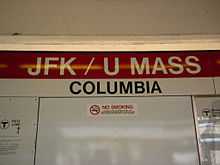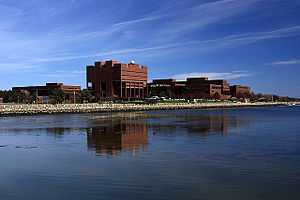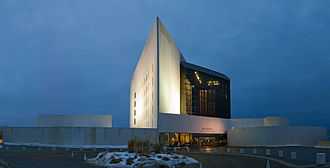JFK/UMass (MBTA station)
JFK/UMASS
JFK/UMASS | ||||||||||||||||||||||||||||
|---|---|---|---|---|---|---|---|---|---|---|---|---|---|---|---|---|---|---|---|---|---|---|---|---|---|---|---|---|
|
A northbound train on the Ashmont Branch platform | ||||||||||||||||||||||||||||
| Location | 599 Old Colony Ave, Boston, MA[1] | |||||||||||||||||||||||||||
| Coordinates | 42°19′14″N 71°03′09″W / 42.32058°N 71.05239°WCoordinates: 42°19′14″N 71°03′09″W / 42.32058°N 71.05239°W | |||||||||||||||||||||||||||
| Owned by | Massachusetts Bay Transportation Authority | |||||||||||||||||||||||||||
| Line(s) | ||||||||||||||||||||||||||||
| Platforms |
1 side platform (Commuter Rail) 2 island platforms (Red Line) | |||||||||||||||||||||||||||
| Tracks |
1 (Commuter Rail) 4 (Red Line) | |||||||||||||||||||||||||||
| Construction | ||||||||||||||||||||||||||||
| Parking | None[1] | |||||||||||||||||||||||||||
| Bicycle facilities | 18 spaces[1] | |||||||||||||||||||||||||||
| Disabled access | Yes | |||||||||||||||||||||||||||
| Other information | ||||||||||||||||||||||||||||
| Fare zone | 1A | |||||||||||||||||||||||||||
| History | ||||||||||||||||||||||||||||
| Opened | November 5, 1927 | |||||||||||||||||||||||||||
| Rebuilt | December 14, 1988[2] | |||||||||||||||||||||||||||
| Previous names | Columbia | |||||||||||||||||||||||||||
| Traffic | ||||||||||||||||||||||||||||
| Passengers (2009) |
7,834 (weekday average on Red Line)[3] 1 (weekday inbound average on commuter rail) | |||||||||||||||||||||||||||
| Services | ||||||||||||||||||||||||||||
| ||||||||||||||||||||||||||||
JFK/UMass Station is a commuter rail and rapid transit station located at the intersection of Columbia Road and Morrissey Boulevard in the Dorchester neighborhood of Boston, Massachusetts. An important transfer station, it connects the Ashmont and Braintree branches of the Red Line with the Plymouth/Kingston, Middleborough/Lakeville and Greenbush commuter rail lines as well as several MBTA Bus routes. Shuttle buses to the University of Massachusetts Boston and the JFK Library are also available from the station.
Station layout
| Ground | Mezzanine and ground levels | Fare control, entrance/exit |
| Platform level | Side platform, doors will open on the left/right | |
| Commuter rail platform | ← Commuter rail lines and CapeFLYER → | |
| Northbound Braintree | ← Red Line toward Alewife (Andrew) | |
| Southbound Braintree | → Red Line toward Braintree (North Quincy) → | |
| Northbound Ashmont | ← Red Line toward Alewife (Andrew) | |
| Southbound Ashmont | → Red Line toward Ashmont (Savin Hill) → | |
The two Red Line island platforms at JFK/UMass have an unusual configuration. This is the only MBTA rapid transit station where trains from different branches of a line serve two separate island platforms; the Ashmont and Braintree branches merge immediately inbound from (or north of) the station. This peculiar platform configuration comes from the historical fact that originally the Braintree Branch trains all bypassed the station, until a separate island platform was later added on for that branch. An automatic illuminated sign at the fare mezzanine level indicates the correct platform for the next inbound train, so that inbound passengers do not have to guess which inbound platform will be served next.
This odd setup can be compared to the junction station at Kenmore, where pairs of tracks serve different Green Line branches from a separate inbound island platform and a separate outbound island platform. The commuter rail stations at Back Bay and Canton Junction have separate platforms for different lines that diverge near those stations.
The unusual configuration is part of a complex track network connecting various segments of the Red Line. North of JFK/UMass station, the mainline tracks coming south from Andrew surface between the tracks leading to Cabot Yard. The yard lead tracks connect to the main tracks on the outside of a flying junction which separates the Ashmont and Braintree tracks.[4] Through the station, the Ashmont Branch tracks are on the west side of the station, with the Braintree tracks in the middle of the station, and the single Old Colony commuter rail track on the east side. South of the station, the Braintree Branch crosses over the commuter rail tracks via a lengthy flyover.[4] There is a plaque, dated 1995, in the station dedicating this "DeVaughn Flyover" to Milton DeVaughn, who "gave his life in pursuit of his duties". DeVaughn, an MBTA track worker, died in December 1993 when he fell under the wheels of an MBTA work train.[5]
In January 2012, the state's Central Transportation Planning staff released a conceptual plan for widening the Southeast Expressway which would also involve completely rearranging JFK/UMass station. The four Red Line tracks would be consolidated to two tracks sharing a single platform, similar to the arrangements at Andrew station. The flying junction between the Ashmont and Braintree branches would be streamlined and moved to just south of the station. This would allow for a second commuter rail track through the station, allowing more commuter trains to stop there and eliminating a major bottleneck for the Old Colony Lines and the Greenbush Line.[6]
History

Old Colony Railroad and BERy
In 1845, the Old Colony Railroad opened between Boston and Plymouth, Massachusetts, and along with it opened Crescent Avenue Depot.[7] Newer depot buildings were built in 1869 and 1883.[8] In 1926, the New York, New Haven, and Hartford Railroad, which had succeeded the Old Colony, closed its Shawmut Branch and sold it to the Boston Elevated Railway. The BERy built its Dorchester Extension of the Cambridge-Dorchester Line subway along the former railroad branch. The mainline stations at Crescent Avenue and Savin Hill were converted to rapid transit-only stations so that express trains to the South Shore and Cape Cod could bypass them. On November 5, 1927, Columbia station opened along with similar stations at Savin Hill and Fields Corner.[2]
MBTA era
Commuter service on the Old Colony lines was ended in 1959, but subway service to Ashmont via Columbia continued. On August 26, 1965, the Cambridge-Dorchester Line rapid transit service was renamed as the Red Line. The color was chosen because the line then ended at Harvard University, whose school color is crimson.[9] In 1971, the Braintree (South Shore) Branch of the Red Line opened; trains ran past Columbia, but did not stop in order to speed travel time between Quincy and Boston.[2]
On December 1, 1982, the station was renamed as JFK/UMass after the nearby Boston campus of University of Massachusetts and the adjacent John F. Kennedy Library, although most station signs are subtitled as Columbia. A new $13.5 million platform for the Braintree Branch (South Shore Line) was opened as part of a general reconstruction on December 14, 1988 and henceforth all Red Line trains have stopped at the renovated station.[2][8]
Commuter rail service on the Middleborough/Lakeville and Plymouth/Kingston lines was restored in September 1997, but the commuter platform at JFK/UMass did not open until April 30, 2001.[2] This was the first time that mainline commuter trains stopped at the station since 1927. Several rush-hour Greenbush Line trains began to stop concurrent with that line's restoration in 2007.[2] Not all weekday commuter trains on the lines stop, however, because the station is in a single-tracked bottleneck section of the otherwise double-tracked route. All weekend trains, which operate on more limited schedules, stop at the station. Conceptual plans released in January 2012 would restore a second commuter rail track through the station, allowing many more trains to stop.[6]
JFK/UMass station was a proposed stop on the MBTA's planned Urban Ring Project.[10] The Urban Ring was a Bus Rapid Transit (BRT) Line designed to connect the existing MBTA lines to reduce strain on the downtown stations. The project is semi-permanently shelved due to the agency's financial difficulties.
In 2012 and 2013, the MBTA installed over 50 security cameras in the station - in addition to around a dozen already present - in response to an increase of crime in nearby areas.[11]
Bus connections


A shuttle bus connects JFK/UMass with the UMass campus and the JFK Library. The station is also served by several MBTA Bus routes:
- 5 City Point - McCormack Housing via Andrew Station
- 8 Harbor Point/UMass - Kenmore Station via B.U. Medical Center & Dudley Station
- 16 Forest Hills Station - Andrew Station or UMass via Columbia Road
- 41 Centre & Eliot Street - JFK/UMass Station via Dudley Station, Centre Street & Jackson Square Station
Nearby destinations
- John F. Kennedy Library
- UMass Boston
- Harbor Art Gallery (located at UMass Boston)
- Massachusetts State Archives
- Boston College High School
- Bayside Exposition Center (sold to UMass Boston in 2010 for redevelopment)[12][13]
- Moakley Park (formerly Columbus Park)
- Carson Beach on Dorchester Bay
- Headquarters of The Boston Globe
- Harbor Point Housing Complex (formerly known as Columbia Point)
References
- ↑ 1.0 1.1 1.2 "JFK/UMass". Massachusetts Bay Transportation Authority. Retrieved 15 January 2012.
- ↑ 2.0 2.1 2.2 2.3 2.4 2.5 Belcher, Jonathan (31 December 2011). "Changes to Transit Service in the MBTA district" (PDF). NETransit. Retrieved 15 January 2012.
- ↑ "Ridership and Service Statistics" (PDF). Massachusetts Bay Transportation Authority. 2010.
- ↑ 4.0 4.1 "Ridership and Service Statistics" (PDF). Massachusetts Bay Transportation Authority. 2009. p. 2.11. Retrieved 7 March 2013.
- ↑ "T worker dies following accident". Boston Globe – via HighBeam Research (subscription required) . 4 December 1993. Retrieved 7 March 2013.
- ↑ 6.0 6.1 Central Transportation Planning Staff (January 2012). "Improving the Southwest Expressway: A Conceptual Plan" (PDF). Boston Region Metropolitan Planning Organization. Retrieved 16 January 2012.
- ↑ Whiting, E., Map of Dorchester Massachusetts in 1850 - Boston Public Library Map Collection. The maps shows the Crescent Avenue Depot of the Old Colony Railroad Line.
- ↑ 8.0 8.1 Cheney, Frank (2002). Boston's Red Line: Bridging the Charles from Alewife to Braintree. Arcadia Publishing. pp. 77–80. ISBN 9780738510477.
- ↑ Kleespies, Gavin W. and MacDonald, Katie. "Transportation History". Harvard Square Business Association. Retrieved 4 October 2011.
- ↑ Executive Office of Transportation, Massachusetts, "Urban Ring Phase 2: FACT SHEET", January 2009
- ↑ Feathers, Todd (30 January 2013). "MBTA installs 50 surveillance cameras at JFK/UMass Red Line stop to fight crime in area". Boston Globe. Retrieved 30 January 2013.
- ↑ Forry, Ed, "UMass-Boston seeks to buy Bayside Expo; Motley says no plans for dorms", The Dorchester Reporter, December 16, 2009
- ↑ Anderson, Hil, "Boston’s Bayside Expo Site Sold to University", Trade Show Executive News, January 2010.
External links
| Wikimedia Commons has media related to JFK/UMass (MBTA station). |
- MBTA - JFK/UMass
- Columbia Road entrance from Google Maps Street View
- Sydney Street entrance from Google Maps Street View
| ||||||||||||||||||||||||||||||||||||||||||||||||||||||||||